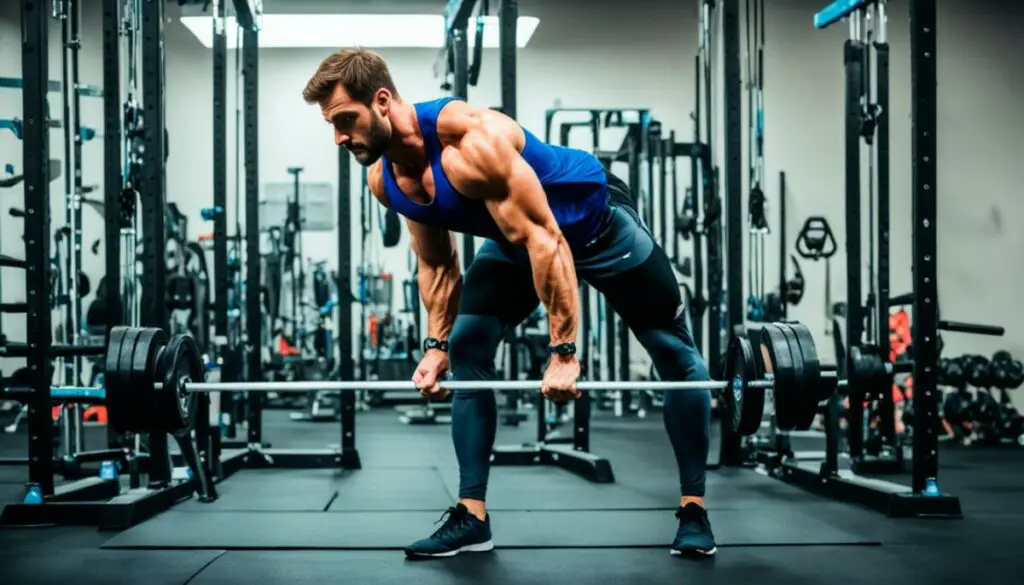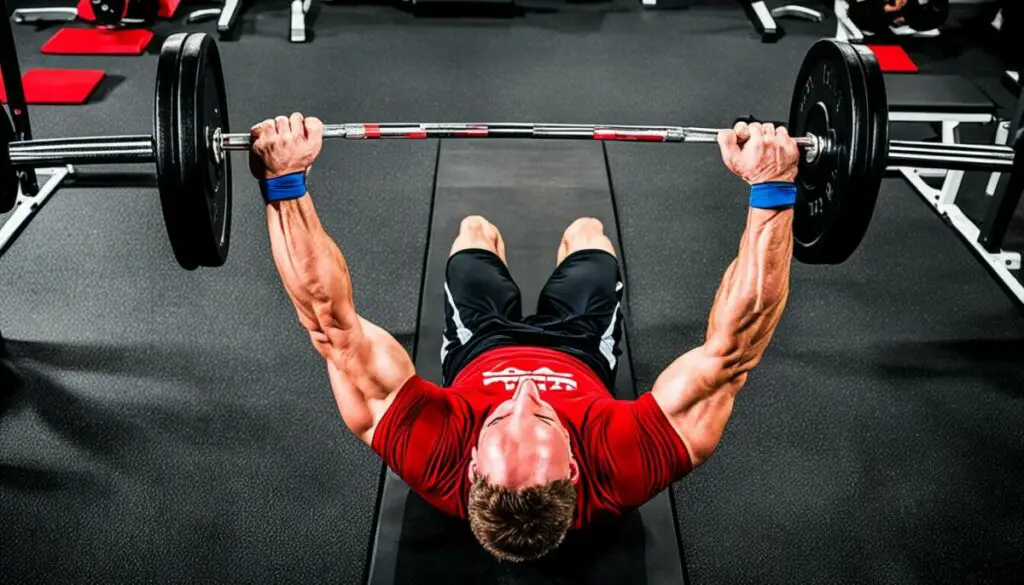Last Updated on 3 months by Francis
The trap bar, also known as the hex bar, is a versatile piece of equipment that can be used for various exercises to increase strength and power. It offers unique benefits such as reduced stress on the lower back and the ability to distribute weight evenly. In this article, we will explore the top trap bar exercises that can help you achieve your fitness goals.
Contents
Key Takeaways:
- Trap bar exercises are effective for building strength and power.
- They provide benefits such as reduced stress on the lower back.
- Trap bar exercises distribute weight evenly, making them suitable for beginners.
- Including trap bar exercises in your workout routine can target multiple muscle groups.
- Whether you’re a beginner or experienced lifter, the trap bar offers versatility and effectiveness in your training.
Trap Bar Bent-Over Row

The trap bar bent-over row is a highly effective exercise that targets the back muscles while minimizing strain on the lower back. It offers a wider, neutral grip, engaging the traps, forearms, biceps, and lats. This back exercise is a fantastic accessory movement for deadlifts and chin-ups, as it strengthens the rowing muscles from a different angle. Incorporating the trap bar bent-over row into your workout routine can help you develop a strong and defined back.
Benefits of the trap bar bent-over row:
- Targets the back muscles effectively
- Reduces strain on the lower back
- Engages multiple muscle groups including the traps, forearms, biceps, and lats
- Helps strengthen rowing muscles from a different angle
Execution:
- Position yourself in front of the trap bar with your feet hip-width apart.
- Bend your knees slightly and maintain a straight back.
- Grasp the trap bar handles with a neutral grip, ensuring that your palms are facing each other.
- With your core engaged, hinge at the hips and lower your torso until it is almost parallel to the ground.
- Keep your elbows close to your body and pull the trap bar towards your midsection, bringing your shoulder blades together.
- Pause for a moment at the top of the movement and squeeze your back muscles.
- Slowly lower the trap bar back to the starting position with control.
- Repeat for the desired number of repetitions.
Tips for an effective trap bar bent-over row:
Focus on maintaining a neutral spine throughout the movement.
Keep your shoulder blades pulled back and down to maximize engagement of the back muscles.
Avoid using momentum or swinging your body to perform the exercise. Maintain control throughout the entire range of motion.
Start with a lighter weight to ensure proper form and gradually increase as you become more comfortable and stronger.
Include the trap bar bent-over row in your back workout routine to enhance your back strength and muscular development. It is a versatile exercise that complements a variety of training programs and can be modified based on your fitness level and goals.
| Trap Bar Bent-Over Row | Target Muscles | Equipment | Level |
|---|---|---|---|
| Back muscles: traps, forearms, biceps, lats | Trap Bar | Beginner to Advanced |
Trap Bar Tall-Kneeling Shoulder Press

The trap bar tall-kneeling shoulder press is a variation of the traditional overhead press that targets the shoulder muscles while providing unique benefits. With a neutral grip, this exercise is easier on the wrists and elbows, making it an excellent option for individuals with joint issues. By assuming a tall-kneeling position, you can also improve core stability and hip mobility, which enhances overall shoulder strength and stability.
When performing the trap bar tall-kneeling shoulder press, ensure you maintain proper form and engage your core for stability. Start by loading the trap bar with an appropriate weight and stepping inside the bar. Assume a tall-kneeling position, with your knees on the floor and your hips aligned with your shoulders. Hold the handles of the trap bar with a neutral grip, resting the bar on your shoulders.
Press the weight overhead by extending your arms while maintaining control. Keep your core tight and your spine aligned throughout the movement. Once you’ve reached the top position, lower the bar back down to your shoulders in a controlled manner. Repeat for the desired number of repetitions.
The trap bar tall-kneeling shoulder press provides a variation to the typical overhead pressing movements, allowing you to target your shoulder muscles from a different angle while reducing strain on your wrists and elbows. It’s an effective exercise for building strength and stability in the shoulders, promoting overall upper body development.
Tips for Trap Bar Tall-Kneeling Shoulder Press:
- Start with a weight that is manageable and gradually increase as you become more comfortable with the exercise.
- Focus on maintaining proper form throughout the movement, keeping your core engaged and your spine aligned.
- Keep the movement smooth and controlled, avoiding any jerking or swinging motions.
- Listen to your body and adjust the exercise as necessary to accommodate any individual limitations or discomfort.
“The trap bar tall-kneeling shoulder press is a versatile exercise that targets the shoulders while providing a neutral grip that is easier on the wrists and elbows.”
Trap Bar Floor Press

The trap bar floor press is an effective chest exercise that combines the benefits of the floor press and the dumbbell press. This exercise allows for a shorter range of motion, which can help you lift heavier weights and enhance your strength. By utilizing the trap bar, you can maintain a neutral grip, which provides a more stable pressing environment and reduces stress on your upper body joints.
The trap bar floor press primarily targets the chest muscles, with secondary engagement of the shoulders and triceps. It is a versatile exercise that can be tailored to your fitness level and goals. Whether you’re a beginner looking to build upper body strength or an experienced lifter aiming to add variation to your routine, the trap bar floor press is a valuable addition to your chest workout.
To perform the trap bar floor press:
- Lie on your back on the floor, with your knees bent and feet flat on the ground.
- Grasp the handles of the trap bar with a neutral grip.
- With your elbows tucked in and your shoulders retracted, lower the barbell until your upper arms lightly touch the floor.
- Press the barbell upward until your arms are fully extended.
Remember to maintain proper form throughout the exercise, keeping your core engaged and your back flat against the floor. As with any exercise, start with a weight that allows you to perform the movement with proper technique and gradually increase the resistance as you become stronger.
The trap bar floor press can be a beneficial addition to your chest workout routine. It offers the advantages of a stable pressing environment, reduced stress on the upper body joints, and the ability to lift heavier weights. By incorporating this exercise into your training, you can target your chest muscles effectively while minimizing the risk of injury.
| Benefits of Trap Bar Floor Press |
|---|
| 1. Engages the chest muscles effectively |
| 2. Provides a more stable pressing environment |
| 3. Reduces stress on the upper body joints |
| 4. allows for a shorter range of motion, aiding in lifting heavier weights |
Trap Bar Romanian Deadlift

The trap bar Romanian deadlift is a highly effective exercise for targeting the posterior chain muscles, including the hamstrings and glutes. This exercise allows you to maintain better form and reduces strain on the lower back compared to conventional barbell deadlifts.
By gripping the hexagonal-shaped trap bar, you can achieve a more stable grip, which enhances your control and stability throughout the movement. The weight is evenly distributed, making it easier to maintain balance and engage the targeted muscle groups.
To perform the trap bar Romanian deadlift:
- Stand in the center of the trap bar with your feet slightly wider than hip-width apart.
- Reach down and grasp the handles of the trap bar with an overhand grip.
- Keep your back straight, chest up, and shoulder blades pulled back.
- Engage your core and glutes as you lift the trap bar by extending your hips and knees.
- As you stand tall, squeeze your glutes at the top of the movement.
- Lower the trap bar back down by hinging at your hips and bending your knees.
- Repeat for the desired number of repetitions.
The trap bar Romanian deadlift is an excellent exercise for building strength, power, and stability in the posterior chain muscles. It can be incorporated into your lower body or full-body workout routine to enhance your overall strength and athletic performance.
Trap Bar Overhead/Shoulder Press

The trap bar overhead press is an effective exercise for building shoulder, chest, and triceps strength. By utilizing the neutral grip provided by the trap bar, this exercise offers a more comfortable position for the wrists and elbows, reducing the risk of injury.
Unlike traditional barbell or dumbbell presses, the trap bar overhead press allows for a more stable pressing movement. This stability translates to improved control and power, leading to increased overall upper body strength.
Performing the trap bar overhead press engages multiple muscle groups, including the deltoids, trapezius, pectoralis major, and triceps. This compound movement helps develop muscle balance and coordination, contributing to a well-rounded upper body workout.
Here’s a step-by-step guide for performing the trap bar overhead press:
- Stand in the center of the trap bar, grasping the handles with a neutral grip.
- Position your feet shoulder-width apart, with a slight bend in your knees.
- Engage your core and keep your back straight throughout the movement.
- Push the handles of the trap bar overhead until your arms are fully extended.
- Slowly lower the trap bar back down to shoulder level, maintaining control.
- Repeat for the desired number of repetitions.
As with any exercise, it’s important to start with a weight that challenges you but still allows for proper form. Gradually increase the weight as you become more comfortable and confident with the movement.
Remember to breathe steadily throughout the exercise. Exhale as you push the trap bar overhead and inhale as you lower it back down.
Benefits of the Trap Bar Overhead/Shoulder Press
The trap bar overhead/shoulder press provides numerous benefits:
- Strengthens the shoulder, chest, and triceps muscles
- Increases upper body stability and control
- Improves muscle balance and coordination
- Reduces the risk of wrist and elbow strain
- Offers a more comfortable pressing movement
- Allows for controlled and powerful overhead pressing
Add the trap bar overhead press to your workout routine to enhance your upper body strength and build a well-rounded physique.
Trap Bar Farmers Walk

The trap bar farmer’s walk is an excellent exercise for building grip strength and overall body strength. It involves walking with a loaded trap bar in each hand, challenging the grip, core, and upper body muscles. This exercise can be beneficial for improving grip strength for deadlifts and chin-ups.
When performing the trap bar farmers walk, start by loading the trap bar with an appropriate weight that challenges your grip. Stand in the center of the trap bar with feet shoulder-width apart and knees slightly bent. Bend at the hips and grab the handles of the trap bar with a firm grip. Make sure to engage your core and maintain an upright posture throughout the exercise.
Once you are in the starting position, lift the trap bar by pushing through your heels and straightening your legs. Stand tall with the trap bar at your sides, and begin walking forward, taking small, controlled steps. Focus on maintaining a strong grip on the handles and keeping your core tight.
You can perform the trap bar farmers walk for a specific distance or for a certain amount of time, depending on your fitness level and goals. As you progress, you can gradually increase the weight on the trap bar to continue challenging your grip strength and overall body strength.
The trap bar farmers walk is a versatile exercise that can be incorporated into your strength training routine. It not only targets the muscles in your hands, forearms, and upper body, but also engages your core and lower body muscles for stability and balance. This exercise is particularly beneficial for athletes, weightlifters, and anyone looking to improve their grip strength for various activities.
Tips for Trap Bar Farmers Walk:
- Choose an appropriate weight that challenges your grip without compromising your form.
- Maintain an upright posture and engage your core throughout the exercise.
- Take small, controlled steps while walking to maintain balance and stability.
- Gradually increase the weight on the trap bar as you get stronger and more comfortable with the exercise.
- Focus on your breathing, inhaling through your nose and exhaling through your mouth to stay relaxed and in control.
Benefits of Trap Bar Farmers Walk:
The trap bar farmers walk offers several benefits, including:
- Grip Strength: The trap bar farmers walk is one of the most effective exercises for building grip strength. By carrying a heavy load in each hand, you challenge your hands and forearms, leading to increased grip strength.
- Overall Body Strength: The trap bar farmers walk engages multiple muscle groups in your upper body, core, and lower body. This exercise helps build strength and muscle in your hands, forearms, shoulders, back, and legs.
- Functional Strength: The trap bar farmers walk mimics real-life movements such as carrying heavy objects. By performing this exercise, you improve your ability to carry groceries, luggage, or other heavy items with ease.
- Improved Core Stability: As you carry the trap bar, your core muscles work hard to maintain balance and stability. This exercise helps strengthen your core muscles, leading to better posture and overall stability.
Adding trap bar farmers walks to your workout routine can have a significant impact on your grip strength, overall body strength, and functional fitness. Whether you’re an athlete, weightlifter, or someone looking to improve their grip strength, this exercise is a great addition to any training program.
Trap Bar Push-Up
The trap bar push-up is a challenging variation of the standard push-up that targets the chest and triceps muscles. By placing your hands on the high handles of the trap bar, you engage additional stabilizer muscles and increase the difficulty of the exercise. This variation not only strengthens the chest and triceps but also enhances upper body stability and strength.
Performing the trap bar push-up is simple:
- Place a trap bar on the floor and assume a standard push-up position.
- Position your hands on the high handles of the trap bar, maintaining a firm grip.
- Lower your chest towards the trap bar by bending your elbows, keeping your body in a straight line.
- Push yourself back up to the starting position, extending your arms fully.
This exercise challenges your chest and triceps muscles while also engaging your core stabilizer muscles. It is an effective way to build upper body strength and stability.
For an added challenge, you can try performing the trap bar push-up with a tempo, such as lowering down slowly and pushing up explosively. This will further engage your muscles and intensify the workout.
By incorporating trap bar push-ups into your workout routine, you can diversify your chest exercises and target your muscles from different angles. Add this variation to your training regimen and experience the benefits of this challenging exercise!
Trap Bar Squat
The trap bar squat is a highly effective exercise for targeting the leg muscles and building overall leg strength. It is a great alternative to traditional barbell squats, offering a more comfortable grip and reducing stress on the lower back and knees.
The trap bar squat primarily engages the quadriceps, hamstrings, and glutes, but it also activates the core muscles for stability and balance.
This exercise is particularly beneficial for individuals with lower back or knee issues, as it allows for a more natural range of motion and helps maintain proper form throughout the movement.
To perform the trap bar squat:
- Stand inside the trap bar with your feet shoulder-width apart.
- Grab the handles of the trap bar, ensuring a firm grip.
- Engage your core, keep your back straight, and initiate the movement by bending at the hips and knees.
- Lower your body down until your thighs are parallel to the floor.
- Push through your heels to return to the starting position.
The trap bar squat can be modified to suit different fitness levels. Beginners can start with bodyweight or lighter weights, gradually increasing the resistance as they gain strength and confidence.
Benefits of Trap Bar Squat
The trap bar squat offers several advantages over traditional barbell squats:
- Reduced stress on the lower back and knees: The trap bar’s design allows for a more upright posture, minimizing strain on the lower back and knees.
- Distribution of weight: The trap bar evenly distributes the weight across both hands, promoting balanced muscle engagement and reducing the risk of muscle imbalances.
- Increased stability: The trap bar’s shape and grip provide greater stability and control during the squatting movement.
- Versatility: The trap bar can be used for various other exercises, making it a valuable addition to any strength training routine.
To illustrate the benefits of trap bar squat, here is a comparison table highlighting the key differences between trap bar squats and traditional barbell squats:
| Trap Bar Squats | Traditional Barbell Squats |
|---|---|
| Reduced stress on lower back and knees | Higher stress on lower back and knees |
| Even weight distribution | Uneven weight distribution |
| Greater stability | Less stability |
| Versatile | Specifically targets quadriceps and glutes |
When incorporating trap bar squats into your leg workout routine, remember to start with lighter weights and focus on proper form and technique. Gradually increase the weight as you progress to challenge your muscles and continue making gains in strength and power.
Conclusion
The trap bar is a valuable tool for strength and power training, offering numerous benefits that can enhance your workout routine. By incorporating trap bar exercises into your training, you can target various muscle groups and achieve your fitness goals more effectively.
One of the major advantages of trap bar training is the reduced stress on the lower back. Unlike traditional barbells, the trap bar allows for a more upright position, minimizing strain on the lumbar spine. This makes it an excellent option for individuals with lower back issues or those looking to prevent injuries.
Additionally, the trap bar’s unique design enables the weight to be evenly distributed, promoting better balance and stability throughout the exercises. Whether you’re performing trap bar squats, bent-over rows, or shoulder presses, you’ll benefit from the enhanced control and reduced risk of imbalances.
Whether you’re new to strength training or an experienced lifter, the trap bar offers a versatile solution for your fitness needs. Its ability to engage multiple muscle groups simultaneously makes it an efficient and effective choice. So, give these top trap bar exercises a try and experience the difference in your strength, power, and overall fitness.
FAQ
What are trap bar exercises?
Trap bar exercises are exercises performed using a trap bar, also known as a hex bar. This piece of equipment is used to target various muscle groups and improve strength and power.
What are some trap bar exercises for beginners?
Some trap bar exercises for beginners include trap bar deadlifts, trap bar squats, trap bar farmer’s carries, trap bar shrugs, trap bar presses, and trap bar lunges.
How can trap bar exercises benefit me?
Trap bar exercises offer unique benefits such as reduced stress on the lower back and the ability to distribute weight evenly. They also target multiple muscle groups and can help improve overall strength and power.
Are trap bar exercises suitable for people with joint issues?
Yes, trap bar exercises can be suitable for people with joint issues. The neutral grip and modified positions in certain exercises, such as the trap bar tall-kneeling shoulder press, can be easier on the wrists and elbows.
What muscle groups do trap bar exercises target?
Trap bar exercises target various muscle groups, including the back muscles (trap bar bent-over rows), shoulders (trap bar overhead press), chest (trap bar floor press), hamstrings and glutes (trap bar Romanian deadlift), and legs (trap bar squats).
Can I use the trap bar to improve my grip strength?
Yes, the trap bar can be used to improve grip strength. Exercises like the trap bar farmer’s walk challenge your grip, core, and upper body muscles, helping to enhance overall body strength and grip strength.



.jpg)




